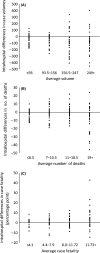Comparison of registry and government evaluation data to ascertain severe trauma cases in Japan
- PMID: 29123904
- PMCID: PMC5649299
- DOI: 10.1002/ams2.302
Comparison of registry and government evaluation data to ascertain severe trauma cases in Japan
Abstract
Aims: Accurate evaluation of health care quality requires high-quality data, and case ascertainment (confirming eligible cases and deaths) is a foundation for accurate data collection. This study examined the accuracy of case ascertainment from two Japanese data sources.
Methods: Using hospital-level data, we investigated the concordance in ascertaining trauma cases between a nationwide trauma registry (the Japan Trauma Data Bank) and annual government evaluations of tertiary hospitals between April 2012 and March 2013. We compared the median values for trauma case volumes, numbers of deaths, and case fatality rates from both data sources, and also evaluated the variability in discrepancies for the intrahospital differences of these outcomes.
Results: The analyses included 136 hospitals. In the registry and annual evaluation data, the median case volumes were 120.5 cases and 180.5 cases, respectively; the median numbers of deaths were 11 and 12, respectively; and the median case fatality rates were 8.1% and 6.4%, respectively. There was broad variability in the intrahospital differences in these outcomes.
Conclusions: The observed discordance between the two data sources implies that these data sources may have inaccuracies in case ascertainment. Measures are needed to evaluate and improve the accuracy of data from these sources.
Keywords: Case ascertainment; quality of care; quality of data; trauma.
Figures


Similar articles
-
Trends in Firearm Injury and Motor Vehicle Crash Case Fatality by Age Group, 2003-2013.JAMA Surg. 2019 Apr 1;154(4):305-310. doi: 10.1001/jamasurg.2018.4685. JAMA Surg. 2019. PMID: 30566198 Free PMC article.
-
Assessment of the completeness and accuracy of case ascertainment in the Michigan Stroke Registry.Circ Cardiovasc Qual Outcomes. 2014 Sep;7(5):757-63. doi: 10.1161/CIRCOUTCOMES.113.000706. Epub 2014 Aug 26. Circ Cardiovasc Qual Outcomes. 2014. PMID: 25160841
-
The missing dead: the problem of case ascertainment in the assessment of trauma center performance.J Trauma. 2009 Apr;66(4):1218-24; discussion 1224-5. doi: 10.1097/TA.0b013e31819a04d2. J Trauma. 2009. PMID: 19359941
-
[Peer review method for quality evaluation--methodology of Emergency Medicine Study Group for Quality about trauma management].J Nippon Med Sch. 2004 Dec;71(6):371-8. doi: 10.1272/jnms.71.371. J Nippon Med Sch. 2004. PMID: 15673957 Review. Japanese.
-
[Japan Trauma Data Bank (JTDB) managed by Japan Trauma Care and Research (JTCR)].Nihon Rinsho. 2016 Feb;74(2):329-36. Nihon Rinsho. 2016. PMID: 26915261 Review. Japanese.
Cited by
-
Trends and characteristics of severe road traffic injuries in children: a nationwide cohort study in Japan.Eur J Trauma Emerg Surg. 2024 Dec;50(6):2631-2640. doi: 10.1007/s00068-023-02372-z. Epub 2023 Oct 17. Eur J Trauma Emerg Surg. 2024. PMID: 37847398 Free PMC article.
-
Current Status, Challenges, and Future Perspectives of Real-World Data and Real-World Evidence in Japan.Drugs Real World Outcomes. 2021 Dec;8(4):459-480. doi: 10.1007/s40801-021-00266-3. Epub 2021 Jun 19. Drugs Real World Outcomes. 2021. PMID: 34148219 Free PMC article. Review.
References
-
- Pronovost PJ, Miller M, Wachter RM. The GAAP in quality measurement and reporting. JAMA 2007; 298: 1800–2. - PubMed
-
- Phillips B, Clark DE, Nathens AB, Shiloach M, Freel AC. Comparison of injury patient information from hospitals with records in both the national trauma data bank and the nationwide inpatient sample. J. Trauma 2008; 64: 768–79. discussion 779–780. - PubMed
-
- McCarthy ML, Shore AD, Serpi T, Gertner M, Demeter L. Comparison of Maryland hospital discharge and trauma registry data. J. Trauma 2005; 58: 154–61. - PubMed
-
- Hackworth J, Askegard‐Giesmann J, Rouse T, Benneyworth B. The trauma registry compared to All Patient Refined Diagnosis Groups (APR‐DRG). Injury 2017; 48: 1063–8. - PubMed
-
- Wynn A, Wise M, Wright MJ, et al Accuracy of administrative and trauma registry databases. J. Trauma 2001; 51: 464–8. - PubMed
LinkOut - more resources
Full Text Sources
Other Literature Sources
Miscellaneous

